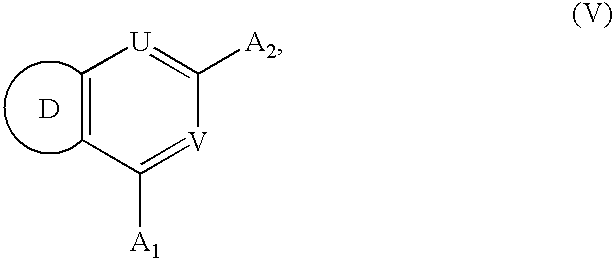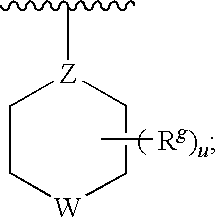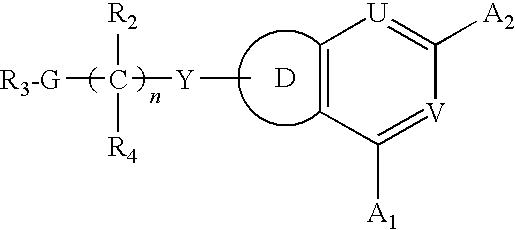Fused hetrocyclic compounds
a technology of hetrocyclic compounds and hetrocyclic compounds, which is applied in the field of hetrocyclic compounds, can solve the problems of excessive pro-inflammatory cytokines and subsequent production, and achieve the effect of inhibiting osteoclast formation
- Summary
- Abstract
- Description
- Claims
- Application Information
AI Technical Summary
Problems solved by technology
Method used
Image
Examples
example 1
Synthesis of N-(6,7-Dimethoxy-2-morpholin-4-yl-quinazolin-4-yl)-N′-(3-methyl-benzylidene)-hydrazine (Compound 1) (See Scheme 1, supra)
[0453]To solution of 2,4-dichloro-6,7-dimethoxyquinazoline (0.26 g, 1 mmol) in 20 ml dichloromethane was added hydrazine (0.040 ml, 1.2 mmol) and dipropyl ethyl amine (0.350 ml, 2 mmol). The reaction was stirred at room temperature for 5 h. The reaction mixture was diluted with water and extracted with CH2Cl2 (50 ml). The organic phase was washed with brine (5 ml) and water (5 ml×2), dried over Na2SO4, and evaporated in vacuo to give a crude product.
[0454]To a solution of the crude product (0.230 g, 0.9 mmol) and m-tolualdehyde (0.120 g, 1 mmol) in MeOH (10 ml) was added acetic acid (1 drop). The reaction mixture was stirred at room temperature for 12 h and solid was precipitated. The resulting precipitate was collected by filtration and washed with a small amount of methanol to give a solid compound (0.240 g) in 75% yield.
[0455]To a solution of the s...
example 2
Synthesis of (6,7-Dimethoxy-2-morpholin-4-yl-quinazolin-4-yl)-(2,3-dimethyl-1H-indol-5-yl)-amine (Compound 2)
[0457]To solution of 2,4-dichloro-6,7-dimethoxyquinazoline (0.16 g, 0.62 mmol) in 10 ml dioxane was added 5-amino-2,3-dimethylindole (0.10 g, 0.62 mmol) and dipropyl ethyl amine (0.140 ml, 0.8 mmol). The reaction mixture was heated at 85° C. for 3 h. After cooling to room temperature, the reaction mixture was diluted with water and extracted with dichloromethane (2×50 ml). The organic phase was washed with water and brine, dried (Na2SO4), filtered, evaporated and purified by flash chromatography on a column of silica gel (hexane-ethyl acetate 4:1) to give a crude product (185 mg) in 80% yield.
[0458]To a solution of the crude product (0.154 g, 0.4 mmol) in 5 ml dioxane was added morpholine (0.175 ml, 2 mmol). The mixture was heated at 85° C. for 6 h. After cooling to room temperature, the reaction mixture was diluted with water and extracted with dichloromethane (2×50 ml). The...
example 3
Synthesis of N-(3-methyl-benzylidene)-N′-(2-morpholin-4-yl-quinazolin-4-yl)-hydrazine (Compound 5)
[0460]Compound 5 was prepared in a similar manner as described in Example 1.
[0461]1H NMR (CDCl3): δ (ppm) 8.75 (s, 1H); 8.55 (m, 1H); 7.92 (s, 1H); 7.58 (m, 4H); 7.22 (m, 3H); 3.91 (m, 4H); 3.82 (m, 4H); 2.42 (s, 3H); ESMS calcd (C20H21N5O): 347.2; found: 348.3 (M+H)+
PUM
| Property | Measurement | Unit |
|---|---|---|
| temperature | aaaaa | aaaaa |
| temperature | aaaaa | aaaaa |
| temperature | aaaaa | aaaaa |
Abstract
Description
Claims
Application Information
 Login to View More
Login to View More - R&D
- Intellectual Property
- Life Sciences
- Materials
- Tech Scout
- Unparalleled Data Quality
- Higher Quality Content
- 60% Fewer Hallucinations
Browse by: Latest US Patents, China's latest patents, Technical Efficacy Thesaurus, Application Domain, Technology Topic, Popular Technical Reports.
© 2025 PatSnap. All rights reserved.Legal|Privacy policy|Modern Slavery Act Transparency Statement|Sitemap|About US| Contact US: help@patsnap.com



